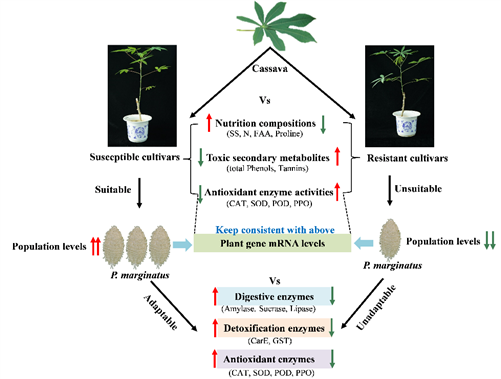The cassava pest prevention and control team of the Environment and Plant Protection Research Institute of the Chinese Academy of Tropical Agricultural Sciences has made new progress in the research on the interaction mechanism of cassava papaya pink scale. The research has identified the host suitability of 15 cassava varieties to papaya pink scale, and revealed the interaction mechanism of cassava papaya pink scale from the aspects of viability and fecundity, enzyme gene expression, digestive detoxification and antioxidant capacity, toxic secondary metabolites and nutrient response, The research results are helpful to better understand the host selectivity of phytophagous insects, and provide a theoretical basis and a new strategy for innovative use of unsuitable host plants to effectively intercept and block the invasion, colonization and expansion of mealybug papaya.

Interaction pattern of cassava papaya pink scale
Paracoccus marginatus is one of the world's dangerous alien invasive pests, and is also one of the four dangerous pests in cassava main planting areas at home and abroad. At present, the research on the host selectivity of Pinocchio papaya to cassava and its interaction mechanism with cassava is very backward, which leads to its rapid invasion and expansion, high frequency of outbreaks, difficult effective monitoring, difficult prevention and control, and increasingly serious damage in cassava area, which seriously affects the sustainable and healthy development of the global cassava industry.
The research team systematically analyzed the feeding suitability of 15 cassava varieties to the papaya pink scale, and found that the resistant non suitable cassava varieties can significantly inhibit the viability, fecundity, digestive detoxification and antioxidant capacity of the papaya pink scale. After being fed by the papaya pink scale, the content of toxic secondary metabolites and nutrients in the resistant non suitable cassava varieties The activity of antioxidant enzymes and the expression of key genes for their synthesis were significantly induced, and the content of malondialdehyde was significantly decreased, which clarified the physiological and biochemical mechanism of cassava papaya pink scale interaction.
The relevant research results were published in the Journal of pest science, an authoritative journal of Entomology, in a research paper entitled "resistant cassava cultures invest the papaya mealybug paracocus marginatus population based on their interaction: from physical and biochemical perspectives". Researcher Chen Qing, assistant researcher Liu Xiaoqiang and associate researcher Liang Xiao of the Environment and Plant Protection Research Institute of CATAS are the co first authors of the paper, and researcher Chen Qing is the corresponding author of the paper. The research was supported by the national cassava industry technology system, the special project of the Ministry of agriculture and rural areas on the investigation, protection and utilization of agricultural resources, and the major science and technology plan of Hainan Province.


